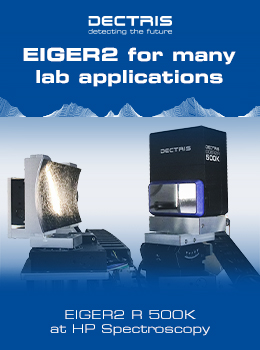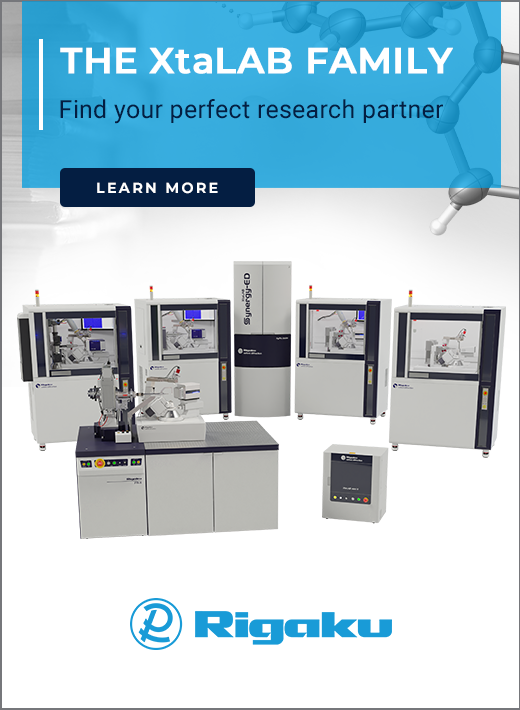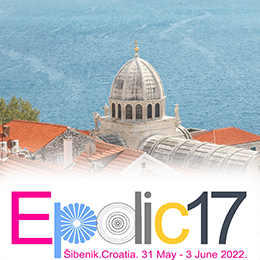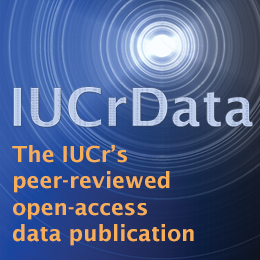


Special report
Crystallography in France, a selective instant view
![Thumbnail [Thumbnail]](https://www.iucr.org/__data/assets/image/0019/154180/thumbnail.png)
Foreword
Academic scientific research in France is based around 70 universities, each with numerous departments, sites and branches, as well as around major research organisations. These include not only the Centre National de la Recherche Scientifique (CNRS), recognised as the second most important research institution in the world (Scimago Institutions Rankings), but also the Commissariat à l'Énergie Atomique et aux Énergies Alternatives (CEA) and the Institut National de la Santé et de la Recherche Médicale (INSERM). In this context, and given the multidisciplinary nature of crystallography, it would appear complex, if not impossible, to draw up a complete and exhaustive overview of the activity of this science in France. This is not the purpose of this article. Nor is it the purpose of this article to relate the importance of the past activities of French researchers in crystallography. We will therefore not talk about Auguste Bravais, Georges Friedel, René Just Haüy or Charles Mauguin, nor about Louis Pasteur or the French crystallographers who were President of the IUCr such as André Guinier, Jean Wyart and André Authier. That is another story. The purpose of this opus is to illustrate the current status and dynamics of crystallography in France by focusing on a few major facts. By definition, the result is partial and probably also unintentionally biased. May the reader excuse us for this. However, despite the inherent flaws of the exercise, an initial mapping of our science in France is sketched out and testifies to a certain dynamism and a swarming of ideas and results, fruits of the hard work of so many colleagues. The purpose of this article is to pay tribute to them as France is preparing to host major crystallographic events in 2022: the 3rd European School and the 7th European Conference on Crystal Growth, July 2022, Paris; the 23rd General Meeting of the International Mineralogical Association, July 2022, Lyon; and the 33rd European Crystallography Meeting, August 2022, Versailles.
1. The French constellation at a glance
On the French territory (Fig. 1), the crystallography community is, in the first place, represented and animated by the French Crystallographic Association (AFC for Association Française de Cristallographie). This is organised around thematic groups of activities (Biology, Chemistry, Physics) and related subjects (crystal growth, large-scale instruments, teaching and scientific mediation). Crystallographers close to mineralogists are also grouped together in the Société Française de Minéralogie et de Cristallographie (SFMC) and in the Groupe Français des Argiles (GFA). More broadly, a constellation of associations and networks covers the numerous interfaces between crystallography and other disciplines, techniques and know-how. For example, the Société Française de Neutronique (SFN) and the Société Française de Biophysique (SFB) promote the interfaces between crystallography and the corresponding disciplines, respectively neutronics and biophysics. We should also point out that there are very active research networks in various crystallography fields, such as structural crystallography, crystal growth and structural biology, with the ЯECIPROCS, CRISTECH and ReNaFoBiS networks, respectively. In some cities, local associations of researchers further promote crystallography on university campuses and towards a wider public. This is the case in Marseille, Bordeaux, Grenoble and Strasbourg, for instance.
French crystallographers meet regularly at national congresses and at more specific colloquia. As everyone knows, crystallographers like to take the parity of a number into account! In even-numbered years (except for pandemic disruptions), the AFC general congress always gathers more than 200 participants [last editions: Marseille (2016), Lyon (2018), Grenoble (2021)]. This figure is also attained in odd years with the Integrative Structural Biology Meeting [Toulouse (2019), Paris-Saclay (2021)], which attracts numerous biologists from the community, and the X-Rays and Matter Conference [Nancy (2019), Aix-en-Provence (2021)], which is of particular interest to physicists and chemists. Among the recurrent national events, we should also mention the User meeting of the SOLEIL synchrotron in January of each year and the Journées de la Diffusion Neutronique - Neutron Scattering Days organized by the French Neutron Scattering Association (SFN). Numerous thematic training sessions or workshops also punctuate the life of the French community and are supported, in particular, by the professional networks.
This constellation of activities and opportunities for interaction between French crystallographers reflects the diversity of this science and its great dynamism. The interface with international bodies, and in particular the IUCr and the ECA, is supported by the French Committee of International Scientific Unions (COFUSI) within the Académie des Sciences.
![[Fig. 1]](https://www.iucr.org/__data/assets/image/0010/154486/Figure1complete.png)
The following paragraphs are dedicated to the recent activities covering the different branches of crystallography in France. They illustrate the complex and dense structure of crystallography in France.
2. Recent activities in biological crystallography
The French structural biology community has been very active over the recent years, standing at the forefront of many areas of biological research and contributing to key technological and methodological developments. In France, as in the rest of the world, the resolution revolution of cryo-electron microscopy (cryo-EM) combined with the development of new tools and instruments to use submicron-sized crystals for crystallographic structure determination, have allowed researchers to tackle challenging projects, most of which were simply out of reach less than a decade ago.
A major focus of recent French structural studies has been on health-related projects, and in many of the examples described below, cryo-EM and X-ray crystallography have been used hand-in-hand to elucidate the mechanisms of action of large molecular machines and identify possible inhibitors of these complexes for therapeutic use. Major structural biology teams from Bordeaux, Grenoble and Strasbourg have notably contributed to the structure determination of several large protein–nucleic acid complexes, including the ribosome, key complexes involved in chromatin assembly and remodelling, and also several bacterial complexes such as the RNA polymerase and DNA gyrase. French researchers from Bordeaux and Marseille have also teamed up to better understand bacterial pathogenesis by revealing, for example, the structure and mode of action of the type VI secretion system [Fig. 2(a)] that is used by bacteria to transfer virulence factors, such as toxins, into their cell hosts.
France hosts several expert teams in the study of integral membrane proteins, which are known to be very difficult to handle and poorly amenable to structural studies. To tackle these challenges, several French laboratories have contributed to the development of new expression, solubilization, stabilization, crystallization and structure determination techniques, which, together with new advances in cryo-EM imaging of membrane proteins, have allowed the elucidation of several remarkable structures. For example, in Grenoble, the Nury team has performed an in-depth study of the mouse serotonin 5-HT3 receptor in different ligand-bound conformations [Fig. 2(b)], and Gordeliy and coworkers have elucidated high-resolution structures of several light-sensitive receptors, including members of the rhodopsin family. These challenging structural biology projects have also benefitted from the expertise of several French theoreticians, such as Chipot and colleagues from Nancy, who bring life to these key assemblies through molecular dynamic simulations.
Structural virology is also an area in which French structural biologists from the Paris area and Grenoble are particularly well established. In recent years, Cusack and colleagues have, for instance, determined structures of several viral DNA and RNA polymerases from different classes of viruses, providing the community with new anti-viral drug targets. Investigations of the structures of entire viruses and viral nucleocapsids have also shed light on the mechanisms by which viral nucleoproteins encapsulate viral genomes. Several studies, notably those led by Gaudin and colleagues, have also focused on the critical interactions between viral glycoproteins and cellular receptors, a key step for allowing entry of viruses into the host cell. Many of these research teams are now heavily involved in COVID-19-related projects. For example, the Rey team from the Pasteur Institute in Paris, took part in some of the first structural studies of the SARS-CoV-2 spike glycoprotein [Fig. 2(c)] and is now actively involved in several additional COVID-19 projects.
Beyond these health-related research projects, several research teams in France are also engaged in the development of new sustainable sources of energy and of novel means to clean-up polluted environments, and here again, structural biology plays a key role. A consortium of researchers from Toulouse and a French biotech company, Carbios, based in Clermont-Ferrand have, for example, succeeded in engineering a "super" enzyme capable of efficiently degrading poly(ethylene terephthalate) or PET. This is the most abundant polyester plastic, largely responsible for the millions of tons of plastics that accumulate worldwide. The elucidation of the high-resolution crystal structure of this enzyme [Fig. 2(d)] has enabled the researchers to improve both its thermostability and catalytic properties. Other researchers from Aix Marseille University recently characterized the structure and activity of an algal enzyme capable of converting fatty acids into hydrocarbons in a single light-driven reaction. Since this initial discovery, the team has demonstrated that the use of such microbes to produce liquid transportation fuels is feasible using a simple E. coli-based cell factory.
These structural biology success stories would not have been possible without new methodological and technological developments to overcome the numerous hurdles encountered in structure determination. Here again, many laboratories in France play major roles in such developments. For example, a lanthanide-based molecular complex, Tb-Xo4, known as the crystallophore, has been identified by Girard and colleagues from Grenoble and Lyon. This complex facilitates crystal growth and solves the phase problem, two of the major hurdles in structural biology. Beyond the recent developments in cryo-EM mentioned above, structural biology has also recently benefited from access to new instruments, such as X-ray free-electron lasers (XFELs), and to new developments in crystallization and data collection devices, notably for serial crystallography at synchrotrons such as SOLEIL or ESRF, in order to perform time-resolved experiments on sub-micron-sized crystals. Such approaches have, for instance, provided key insights into photoswitching and photoconversion mechanisms within fluorescent proteins that occur at the nanosecond to millisecond timescale. Serial femtosecond crystallography has also recently been used by a large consortium of researchers to elucidate the structure of a mosquitocidal protein, Cyt1A, using submicron-sized in vivo grown crystals [Fig. 2(e)].
The French structural biology community benefits from access to a number of national and international large-scale facilities, such as SOLEIL or ESRF, and numerous technological platforms through the French Infrastructure for Integrated Structural Biology (FRISBI) centres in Strasbourg, Grenoble, Montpellier, Marseille and Paris. A French national training network in structural biology (ReNaFoBiS) was also set up in 2013 to coordinate the different teaching courses and training programmes available for students and young scientists. In 2019 and 2021, the AFC and the French Biophysics Society jointly organized the first two French biennial Integrative Structural Biology Meetings (BSI2019 and BSI2021), first in Toulouse, then in Paris-Saclay. These have been a great success, bringing together this dynamic structural biology community for a week of scientific exchange.
![[Fig. 2]](https://www.iucr.org/__data/assets/image/0011/154487/Fig.-2.png)
3. Recent activities in chemical crystallography
Chemical crystallography is often defined as the application of diffraction techniques to the study of structural chemistry. Almost all universities and academic research centres (CNRS, CEA etc.) in France are equipped with X-ray diffractometers for routine and non-routine structural analyses. Most of the X-ray services are managed by only one or more trained crystallographers, and research groups dedicated to only chemical crystallography do not exist anymore in France, although many chemical crystallographers serve research groups across the whole country. Taken together, almost all aspects of chemical crystallography are covered in France.
Many chemical crystallographers are gathered in the ЯECIPROCS network, which organizes every year meetings and training sessions on a diversity of topics, very often oriented towards the mastering of new and old crystallographic software packages. The network has also implemented a national online training course on the radiation safety aspects of laboratory diffractometers.
It is difficult to specify in which subdisciplines of chemical crystallography France is particularly outstanding, but France has a very strong track record in at least four areas: development of software for chemical crystallography, high-pressure diffraction, crystallographic battery research and electron diffraction. Some recent examples of each of these areas will be given here.
![[Fig. 3]](https://www.iucr.org/__data/assets/image/0006/154473/Figure3.png)
Software for chemical crystallography
The development of software for chemical crystallography in France has been a success story for more than four decades. One of the most popular packages for Le Bail and Rietveld powder diffraction refinements, FULLPROF, was developed at the Institut Laue Langevin by J. Rodriguez-Carvajal in Grenoble starting from the late 1980s. This package still receives updates at least three or four times per year, implementing new functionalities and bug fixes. The Le Bail refinement part of FULLPROF had actually been developed before the first FULLPROF release by the Laboratoire des Fluorures in Le Mans. This method revolutionized the refinement of cell parameters from powder data, which was hitherto done by least-squares refinement on peak positions only but could then be performed as a full-pattern refinement without knowledge of the atomic structure. It additionally offered the possibility to obtain more accurate peak intensities for structure solution from powder data. FULLPROF is almost always interfaced by the WINPLOTR graphical software package developed since 1998 at the University of Rennes (T. Roisnel), and which is still regularly updated with new releases several times per year. Another famous program, DICVOL, was written at the same university, implementing the successive dichotomy method for ab initio peak indexing. DICVOL is still used all over the world as a stand-alone program or is interfaced with other programs such as WINPLOTR. For the intermediate step between peak indexing and structural refinements, FOX (Fig. 3) was developed initially at the University of Geneva before being continued after some years in Grenoble until today by V. Favre-Nicolin, co-laureate of AFC's André Guinier prize together with G. Bricogne in 2020. FOX is one of the most used and successful ab initio structure solution packages for powder diffraction. The original 2002 publication on FOX received more than 1300 citations, of which about 60 were in 2021. Finally, the bilateral Italian-French program MAUD (Caen) is still the international reference for the so-called combined approach, where data from diffraction experiments are combined with data from X-ray reflectivity or fluorescence measurements.
Several French software packages exist to analyze electron density derived from experimental single-crystal diffraction data or ab initio calculations. MOPRO, and the associated MOPROViewer program (University of Nancy), can be used to refine high-resolution electron densities by multipole structural refinements and also to determine and visualize derived topological quantities. MOPRO is also interfaced with the ELMAM2 experimental multipolar database, which groups multipolar parameters necessary to describe the charge density of proteins and common chemical groups. Both programs are still being actively developed. Another approach for analyzing electron density properties, the non-covalent interactions (NCI) method, was made popular by the NCIPLOT program being coded at the Laboratory for Theoretical Chemistry in Paris (J. Contreras-Garcia). Extensions to the method, notably the Independent Gradient Model (IGM), have been proposed by researchers at the University of Reims and implemented in their IGMPLOT program.
Chemical high-pressure diffraction
France has several centres of excellence for chemically related high-pressure research. The group led by J. Haines at the University of Montpellier seeks to use high pressure to synthesize chemical species that cannot be synthesized otherwise. These may have very different properties at non-ambient conditions or may change drastically the properties of the materials in which they are confined at high pressure. During the last years, this ongoing research is oriented towards the high-pressure synthesis of linear or sinusoidal molecular strings inside the pores of different zeolite framework structures. The group notably tries to synthesize by high-pressure techniques confined boron nitride nanowires having exceptional photonic properties with a narrow emission for far-ultraviolet wavelengths. High-pressure diffraction, and also high-pressure Raman and infrared (IR) spectroscopy, are used to characterize the obtained materials.
A research group at Sorbonne University in Paris (S. Klotz) is specialized in high-pressure chemical research by neutron scattering, for instance, in the field of simple molecular systems under high pressure, such as solid oxygen. Another important research topic is related to the methodology and metrology of high-pressure diffraction experiments. In collaboration with Japanese groups, a new high-pressure cell for neutron diffraction experiments using nano-polycrystalline anvils has recently been proposed. This group is also involved in the International Practical Pressure Scale project, which aims to define a practical pressure scale for high-pressure research.
Special phenomena occurring in transition metal complexes such as spin-crossover transitions are thoroughly investigated in Toulouse (G. Molnár) and Bordeaux (P. Guionneau). These crossovers can be induced by pressure, temperature, light or other external fields. Molecular spin-crossover compounds can potentially be used for mechanical actuation purposes: an illuminating example was recently given for a Fe spin-crossover compound. In this case, the complete set of elastic moduli was determined by a combination of high-pressure diffraction, nuclear inelastic scattering and micromechanical measurements. Variable temperature high-pressure X-ray powder diffraction using synchrotron radiation has also revealed the actual volume variations of these materials.
Crystallographic battery research
There are several very active research groups in France that use X-ray and neutron diffraction studies to investigate the operando behaviour of batteries. Research groups in Amiens, Bordeaux and Paris often collaborate in the context of the French network for electrochemical energy storage (RS2E). The use very sophisticated experiments involving operando electrochemical cells coupled to laboratory or synchrotron diffraction or absorption spectroscopy setups. In a recent publication, they showed the feasibility of reversibly intercalating Li+ electrochemically into VX3 layered halides by using superconcentrated electrolytes. This was done by using a combination of electrochemical and solubility measurements with structural operando synchrotron X-ray and neutron diffraction. This is a change of paradigm as almost all research was until then focused on layered oxides or sulfides.
The Monconduit group at the University of Montpellier has a very strong track record in operando research by diffraction and pair distribution function analysis on battery systems, shifting in recent years to the study of potassium ion batteries as alternatives to relatively high-cost lithium ion batteries. The structural behaviour of systems with notably Sb and Bi electrodes has been investigated using laboratory equipment during electrochemical cycles.
Electron diffraction
During the last five years, electron diffraction for structural chemistry has been developed in France by groups in Caen and Lille. The Caen group (P. Boullay) showed in 2017, in collaboration with a group from the Institute of Physics in Prague, how hydrogen atoms could be located in organic compounds using electron diffraction data obtained from nano-sized crystals. The Roussel group in Lille is mainly involved in the structural resolution of complex natural and synthetic oxides by a combination of powder diffraction techniques and dynamic refinement of precession electron diffraction data on submicron-sized samples. Both groups are actively involved in the organization of workshops for electron diffraction in France, e.g. the CrystElec schools of which the third edition took place in Grenoble in October 2021. This year three different electron diffraction schools are being organized in France.
4. Recent activities in physical crystallography
Crystallography plays an important role in condensed matter physics, and the French community of crystallographers demonstrates intense activity at the forefront of various aspects of research in this domain. Below, we present just a few selected examples of the more salient recent results.
One of the most vivid parts of this activity has been for a long time the investigation of the relationship between crystal structure and the physical properties of materials, which was strongly boosted after the discovery of high-Tc superconducting cuprates in the late 1980s, and later on with GMR/CMR manganites or superconducting pnictides. Understanding the mechanisms at the origin of these intriguing properties has required detailed knowledge of their structural phase diagrams as a function of composition (i.e. electronic doping level), temperature or pressure. French crystallographers have widely contributed to such studies, with strong contributions from several research teams, notably in Orsay, Caen and Grenoble, primarily involving neutron scattering studies of crystal and magnetic structures at the Leon Brillouin Laboratory (LLB) reactor in Saclay and the Institut Laue Langevin (ILL) in Grenoble. More recently, the renewed interest for compounds displaying the coexistence/competition of different properties (e.g. magneto-electricity, multiferroism …) has stressed the central role of the crystal structure, as these crossed-linked effects are largely controlled by the symmetry of the material. New concepts have recently appeared in this field, such as the so-called hybrid improper-ferroelectricity, based on for example doubly ordered cation substitutions in perovskite-based compounds leading to a wealth of magnetic/structural phase transitions. Among others, the team of C. V. Colin in Grenoble has produced pioneering results to understand the physical mechanisms for multiferroism and magneto-electric behaviour of one-dimensional magnetic pyroxenes, and hybrid improper ferroelectricity and magnetism in NaLnMWO6 doubly-ordered perovskites. These works, based on synchrotron and neutron diffraction measurements as a function of temperature and Rietveld refinements (using the FULLPROF software), make use of the symmetry-adapted analysis concept, allowing one to discriminate the distortion modes, which are relevant to the structural phase transitions. A lot of work has also been carried out by teams in Orsay (F. Damay) and Grenoble (V. Simonet) on non-conventional magnetic oxides, which display magnetic frustration and complex magnetic/structural interactions leading to anomalous magnetic orders, structural distortions or chiral effects. These results emphasize the central role played by symmetry and fine structural details for the existence of these properties, which need to be determined accurately to discriminate between various proposed mechanisms. The role of neutron scattering for these investigations must be stressed again, and the recent closure of the Orphée reactor in Saclay may represent a severe hindrance to their developments.
Phase transitions at high temperature are of paramount importance for the mechanical behaviour of industrial ceramics. A careful experimental reciprocal space investigation coupled to precise modelling of the effect of the various phenomena occurring at the transition (cracks, distortions, strain, …) on the diffraction signal has been carried out by the team of R. Guinebretière (Limoges) to reach a quantitative description of the martensitic phase transition up to 1500°C in ZrO2 dense ceramics. This allowed one to disentangle the complex behaviour of the sample microstructure through heating and cooling and demonstrates the great potential of such experiments to understand the mechanical properties of materials.
With the recent major advances of synchrotron sources, the interest of the community becomes more directed towards the local scale, i.e. in situ and/or operando and fast phenomena investigations. The boom of nanosciences forces crystallographers to adapt their experimental techniques to tackle the problems brought about by the need to describe the structure of nanomaterials at the local scale. One angle of attack is to make use of the Pair Distribution Function, obtained by Fourier transforming powder diffraction data, which provides multi-scale information on the structure and microstructure, disregarding the level of crystallinity of the material. Requiring high-energy and high-flux sources, this growing technique now benefits from well-adapted beamlines at synchrotron sources, such as the CRISTAL beamline at SOLEIL, the French-CRG beamline D2AM and several others at ESRF (ID22, ID11…). This is becoming increasingly popular in laboratories, with the availability of Ag Kα radiation sources and efficient 2D detectors. Recent examples of applications by French teams to physics research topics stem from the in-situ study of catalyst nanoparticle growth, the phase transformation/amorphization of pharmaceutical molecules by high-energy milling in situ (Grenoble) and the study of water confinement in mesoporous materials (Nancy).
Another quite different approach to the study of local structure is the investigation of single objects using coherent X-ray diffraction imaging. The Aix-Marseille team of M.-I. Richard is the leader in this emerging method, which they applied, for example, to the reconstruction of catalytic single nanoparticles, allowing one to observe the strain state of the different facets and detect twin boundaries and their evolution during the catalytic process (see Fig. 4). In this context, the PyNX software package, developed by V. Favre-Nicolin, has rapidly become a key tool for image reconstruction from a coherent diffraction signal and ptychography. Coherent diffraction has also been extensively used by the Orsay/SOLEIL team of S. Ravy for the investigation of charge-density waves (CDWs), for which they have developed unique expertise. For example, they were able to provide remarkable results on the role of surface pinning on the flow of CDWs exposed to an external field. With C. Lhaulé, this team has also developed ultra-fast (subpicosecond) diffraction measurements at the CRISTAL beamline at SOLEIL, used to study out-of-equilibrium states in crystalline solids in pump–probe experiments. In Rennes, the team of E. Collet has a leading role in the study of photo-induced phenomena by ultra-fast diffraction. They have naturally turned to using the extraordinary possibilities provided by XFELs for this type of measurement with time resolutions down to femtoseconds. As an example, this team recently used XANES data to study the development of the coupled charge transfer between metals in a Co–Fe Prussian blue analogue and how it evolves in time, showing that the photoinduced spin transition of Co atoms from low- to high-spin state induces a charge transfer to Fe atoms from FeII to FeIII. Also, using femtosecond X-ray diffraction experiments at the Swiss X-FEL, they revealed how electronic and structural precursor phenomena generate strain waves and a coherent macroscopic transformation pathway for the semiconducting-to-metal transition in bistable Ti3O5 nanocrystals. Such pioneering works pave the way for future discoveries in the yet unexplored domain of ultrafast physical phenomena.
![[Fig. 4]](https://www.iucr.org/__data/assets/image/0005/154490/Fig.-4.png)
5. Recent activities in mineralogy related to crystallography
The French mineralogical community has developed strong interactions with the physical and chemical crystallography communities. Major advances have been made in fields covering a wide range of thermodynamic conditions, from ambient low-temperature conditions to the highest pressures and temperatures that can be experimentally obtained. Many of these successes have relied on combining advanced experimental studies and up-to-date molecular modelling approaches. Particular interests are devoted to the point or extended defects occurring in minerals, as well as to the changes in mineral properties when their characteristic size goes from the macroscopic scale down to nanometric particles. Departure from the ideal structure is the rule for naturally formed crystals, affecting their physical-chemical properties and bringing important information on their growth conditions and subsequent geological history.
At high pressures and temperatures, investigations aim at unravelling the nature and properties of the materials occurring in the innermost parts of the Earth and other planets, including those orbiting around other stars. Elucidation of the structure of the phases with relevant chemical compositions under extreme conditions is key information for the interpretation of large-scale geophysical observations, and this makes strong constraints in the establishment of geochemical balances. Concerning this last point, studies addressing the incorporation mechanisms in the high-pressure crystal structures of volatile elements, such as hydrogen, noble gases, halogens or oxidized forms of carbon, are particularly relevant. Such investigations are performed in Paris in close collaboration with groups specialized in high-pressure physical crystallography. Major advances at Lille and Montpellier have also been achieved in the understanding of the deformation mechanisms of major rock-forming minerals. Studies in this field include advanced electron diffraction techniques and the multi-scale modelling of deformation, from the atomic to the polycrystal scale. More generally, the study of deformation and transformation mechanisms of minerals has important implications for understanding major geological processes ranging from convection in the Earth's mantle to the building of mountain chains. The microstructure of deformed minerals in the Earth's crust has received detailed attention because it is an indicator of stress/strain in rocks. Investigations conducted in Paris on the mechanical twinning of calcite have refined its use for paleopiezometric and tectonic studies. Geological implications of the radiation-induced transition from the crystalline to the amorphous state of radioactive minerals are also explored in Saint Etienne.
Under milder ambient conditions, a major interest is the study of the growth of crystals from aqueous solutions. Studies aiming at elucidating the multi-step nucleation processes of sulfates, phosphates and carbonates are conducted in Grenoble and Marseille. They have important implications for the understanding of minerals in planetary surface environments, as well as in biological fluids. Incorporation of molecular impurities in the crystal structure is of particular importance because some of these impurities are used as indicators of past conditions prevailing at the Earth's surface, contributing to paleoclimatic and paleoecologic reconstructions. Elucidating the control of crystal growth by living organisms is a major research field in biomineralogy. The formation of specific crystal shapes and their potential use as biogenicity indicators in ancient rocks has attracted detailed studies of the controlled growth of magnetites in magneto-tactic bacteria.
Also typical of hydrothermal and lower-temperature environments, clay minerals are finely divided layered silicates displaying stacking disorder, extended chemical variability and submicrometric particles. They share these properties with other natural phases with layered structures such as manganates or imogolites. A property of some of these layered minerals is also that they incorporate molecular species as well as cations in their interlayer spacing, depending on the properties of the surrounding aqueous solutions or atmosphere. Because of their ubiquitous occurrence and small grain size, they play a key role in many natural processes. The crystallography of clay minerals is a very active field in France with a strong relation to chemical crystallography. Studies led at Grenoble, Poitiers, Toulouse and Orsay aim at unravelling the real structure of these minerals and its relation to specific properties. In this context, development of codes dedicated to the modelling of diffraction patterns of disordered layered structures plays a key role.
Closer to crystalline perfection, but still related to crystal growth mechanisms, the natural formation of minerals of gem quality is a fascinating field in which researchers from Nantes and Aix-en-Provence have world-recognized expertise. Fundamental studies of the expression of crystal symmetry and twinning in minerals are being developed in Nancy. Lastly, French research activities related to mineral crystallography also benefit from the close connection to the Mineral Collections (see a great example of calcite in Fig. 5). For instance, the system of donation or loan of samples set up by the two mineral collections of Sorbonne University and of the Muséum national d'Histoire naturelle (MNHN) is very much appreciated and routinely used by the French mineralogical community.
![[Fig. 5]](https://www.iucr.org/__data/assets/image/0003/154479/Figure-5.jpg)
6. Recent activities in crystal growth
The AFC crystal growth transverse axis was set up in 2018 and is led by the French Committee for Crystal Growth (CFCC). Its two main goals are to 1) ensure national and international visibility of the French crystal growth communities and networks, both in national and in international scientific bodies such as the International Organization for Crystal Growth, the European Network of Crystal Growth, the IUCr and its Commission on Crystal Growth and Characterization of Materials; 2) organize national or international scientific events, and coordinate many initiatives (workshops, schools, national training actions, topical days etc.), in the realm of crystal growth and related characterizations.
Several scientific communities, technological networks and research consortia (mostly CNRS-funded) are now federated at the French level: the CRISTAL community focused on the research in industrial crystallization and precipitation; the High-Pressures network dedicated to high pressures; French members of the International Organization for Biological Crystallography (IOBCr); the CRISTECH network for crystal growth and crystallization technologies; the CMDO+ network for optical crystals, micro- and nanostructures, and devices; the Research Group (GDR for Groupe de Recherche), PULSE, gathering the experts of basic mechanisms driving epitaxial growth, its new topics and emerging technologies, as well as the properties and applications of epitaxial systems; the GDR, SAM, dedicated to the science of solidification; the GDR, OXYFUN, that focuses on transition metal oxides in thin films and on growth and characterization of superstructures and their implementation in devices; and the RECITAL network for users of the pulsed laser deposition technique and related instrumentation applied to thin-film crystal growth.
Consequently, the research topics covered by the entire French crystal growth community not only encompass bulk crystal growth activities but also include many more scientific and technological branches. These include the following: fundamentals of nucleation and crystal growth (theory, modelling and experiments designed to learn the fundamental aspects of nucleation and crystal growth); crystallization mechanisms, morphological and/or growth instabilities, growth technologies and process control; development of new methods and approaches for bulk growth, structure and properties of solid–vapour, solid–liquid and solid–solid interfaces; physical, chemical and technological aspects of thin-film formation and epitaxial growth; structural defects and impurities in crystalline materials, surface and bulk defects; crystal growth and characterization of nanostructures, low-dimensional and confined systems (nanoparticles, quantum dots, nanowires, nanotubes etc.); growth of advanced inorganic materials (mesocrystals and colloidal systems); crystallization in organic and biological systems (organic, macromolecular and biomolecular crystals, protein and polymer crystalline materials, current advancements in biomineralization); industrial crystallization, technologies and process control; crystal growth under a variety of external fields and extreme conditions – electric fields, magnetic fields, hyper- and microgravity, radiation, vibration, ultrasonic, high pressure, thermal and mechanical stress etc.; advanced growth technologies; advances in observation and characterization methods such as in situ monitoring methods and analysis of physical, structural and chemical properties of crystals (microscopy, spectroscopy, radiography, topography, scattering and other characterization techniques, as well as recent advances in in situ monitoring methods, see Fig. 6). Virtually all types of materials are addressed in the investigations covered by the AFC crystal growth transverse axis.
French teams from the crystal growth community have also contributed to several important advances in the field in recent years:
Heretofore ungrown crystals have been created, such as high-Verdet constant cubic Tb2O3 or highly Yb3+-doped cubic Gd2O3 laser crystals, optical-floating zone- or flux-grown BaZrO3 crystals, oxygen annealing-enhanced piezoelectric and ferroelectric flux-grown (K,Na,Li)(Nb,Ta,Sb)O3 single crystals (Dr Ph. Veber - Luminescence Team/ILM, Lyon);
New in situ observations-based phase-field models have been implemented, including strong interfacial anisotropy effects in eutectic growth, which are now capable of accounting for crystallographic features at triple lines, opening new perspectives for epitaxial growth and nanowire growth (Dr S. Akamatsu/INP, Paris, and Professor Dr M. Plapp/Condensed Matter Physics Laboratory, Palaiseau);
New engineering strategies are being established for producing defect-free SiGe strained nanolayers and of chemical strain engineering of magnetism in oxide thin films (control of the oxygen vacancies content during the epitaxial growth of PrVO3 thin films on a SrTiO3 substrate);
Droplet-based microfluidic platforms have been designed for both the optimization of crystallization conditions and outputs, and the precise determination of solubilities, which is compatible with any solvent and can address an extensive range of materials, such as APIs or membrane proteins, where the coupling with UV-Vis and Raman spectroscopies also allows the study of compound polymorphism (Dr R. Grossier/CINaM, Marseille);
New devices have been developed for in situ and time-resolved X-ray imaging of high-melting-temperature materials (up to 1600°C) with simultaneous recording of X-ray radiography and topography images of the solid–liquid interface. This has been applied to the solidification of silicon and superalloys. The dynamics of formation and development of structural defects (e.g. dislocations, twins, small-angle grain boundaries) of microstructures (dendrites) and grains can be characterized during solidification using these X-ray imaging methods (Dr N. Mangelinck-Noël, Dr G. Reinhart, Dr G. Regula/IM2NP, Marseille).
Among the most recent and significant events organized by members of the CFCC, one should mention the annual bilateral Workshop on Oxide, Dielectric and Laser single crystals (Bordeaux 2017, Idar-Oberstein 2018, Lyon 2019, Berlin 2020, Idar-Oberstein 2021, Lyon 2022), which is now alternately organized in France and Germany, and the national training actions on X-ray diffraction applied to crystal growth (including in situ techniques, Grenoble 2019) and on the Fundamentals of crystal growth (Lyon 2019). The CFCC is currently busy working on the organization and the academic programme of the forthcoming 3rd European School on Crystal Growth (ESCG3, Paris, 20–23 July 2022) and on the organization of the closely related 7th European Conference on Crystal Growth (ECCG7, Paris 25–27 July 2022).
![[Fig. 6]](https://www.iucr.org/__data/assets/image/0003/154488/Fig.-6.png)
7. Overview and perspectives on large-scale facilities in France
Experimental crystallography is fundamentally based on the interaction between condensed matter and different types of waves or particles. The development of our science is thus strongly linked to our ability to set up convenient and high-performance instruments around efficient radiation sources. In France, a large number of laboratory platforms, implemented either in individual research laboratories or increasingly shared between different research groups, are available in most of the main academic centres. Nevertheless, although very interesting technical developments are continually improving the capabilities of laboratory instruments, it is quite clear that large-scale facilities now play a crucial role in the development of crystallography. As crystallographers, we benefit in France from the implantation of both national and European large-scale facilities that can be classified with respect to the nature of the radiation they use. The average structures of crystals, the nature and density of defects in crystals, as well as the microstructure of polycrystals, can be studied at the quantitative level using X-rays, neutrons, electrons or NMR. Large-scale facilities allowing us to develop a wide diversity of experiments based on scattering, diffraction, absorption, emission or nuclear interaction have been implemented in France (Fig. 7).
The European Synchrotron Radiation Facility (ESRF), located in Grenoble, recently upgraded through the Extremely Bright Source (EBS) programme, is currently one of the most brilliant X-ray sources present around the world. France is the major financial contributor to the ESRF. In August 2020, it became the first fourth-generation synchrotron radiation source open to users. Forty-eight beamlines are currently open. Many of them are devoted to advanced experiments on crystals. Five of these beamlines are operated, as a French Collaborating Research Group (F-CRG), directly by the French scientific community and a large part of the experiments performed on these beamlines are strongly related to crystallography. The French national synchrotron radiation source, SOLEIL, is located near Paris. One of the main features of this source is its very broad energy range covering a large part of the electromagnetic spectrum, from infrared to hard X-rays (a few µeV to a few keV). Twenty-nine beamlines are currently open to users. Besides two beamlines devoted to structural biology, several others are dedicated to the study of single- or polycrystals through X-ray scattering, absorption or emission process. SOLEIL opened in 2008 for the users and an ambitious upgrade programme has recently been launched that will involve two phases and will end in 2030.
Besides the use of X-rays, the French crystallographers have been, for at least the past five decades, very much involved in the study of crystals using neutrons. The Institut Laue-Langevin (ILL) located in Grenoble near the ESRF, was inaugurated in 1971, and represents one of the most famous neutron sources around the world. It is a European source associating France, Germany and the United Kingdom in partnership with 11 other countries. A second national reactor, Orphée, located near Paris, was operated by the Laboratoire Léon Brillouin (LLB) from 1980 until 2019. This unique situation of having two neutron reactors in France has favoured the growth of a large French neutron users' community that brings together roughly 2000 researchers, of which a large part are crystallographers. This community, led by the Fédération Française de Diffusion Neutronique, is in charge of six different instruments located at the ILL and is heavily involved in the development of new instruments for the European Spallation Source (ESS) in Lund, Sweden. Moreover, the project of a national, medium-scale neutron source has also been launched.
At the interface between material science and crystallography, the community of French electron microscopists has built a vast network that brings together the larger French electron microscopy centres and the atom probe tomography facilities. This network, called METSA (for Transmission Electron Microscopy and Atom Probe), associating eight regional platforms, offers a large number of unique up-to-date instruments. Similarly, NMR instruments spread over seven scientific high-level platforms are organized through the IR-RMN network. Mainly devoted to the study of solid-state NMR, this network is largely used by crystallographers. Access to the facilities within these two networks is organized through periodic calls for proposals as for access to large-scale X-ray and neutron sources.
![[Fig. 7]](https://www.iucr.org/__data/assets/image/0007/154474/Figure7largeinstruments.png)
8. A few words on teaching crystallography
Teaching crystallography is a fascinating and difficult task. This is not a French specificity, of course, but a common, universal trait, which originates in the eminently transdisciplinary character of our science. In France, as in many other countries, the teaching of crystallography is being cut back as university curricula are revised. The erosion is rapid as in France the content of university courses is discussed and redefined every four or five years. The erosion seems to be definitive as the general trend is to reduce the volume of teaching hours. In this context, defending a teaching module explicitly bearing the term "crystallography" is a Herculean task. However, whether in chemistry, biology, geology or physics, knowledge of crystallography constitutes the pillar, albeit sometimes masked, of many courses in Bachelor's (3 years) and Master's (5 years) degrees in materials science, solid-state physics and chemistry, biophysics or archaeometry for example. Whereas the standardization of degrees in Europe (LMD system) has had the consequence of restricting degrees focusing on crystallography, it has made it possible to teach crystallography at the doctoral level. A large number of courses for students in the course of their theses are offered on university campuses in France. This may be considered a little late, but it has the merit of providing a high level of specialized training centred on concrete problems such as the refinement of crystal structures of macromolecules, the determination of microstructural parameters or integrative structural determination in biology. To overcome the lack of initial training in crystallography, many ingenious initiatives are being undertaken, for example in the form of Massive Open Online Courses or MOOCs.
Also, the dichotomy between the remarkable dynamism of the crystallographic community in France and the steady loss of substantial educational courses in this discipline is starting to move the lines. The 2014 International Year of Crystallography driven by the IUCr was no stranger to this. In this year, indeed, France was the scene of an incredible number of events of all kinds in tribute to crystallography. The enthusiasm of the general public gave a new energy to all the French actors of crystallography and resonated in many minds. A first major repercussion of this event was the reintroduction in 2019 of crystallography in the national high-school science curriculum. Marking a major comeback for younger students, crystallography has proved difficult to handle for existing secondary school teachers, most of whom come from a background lacking crystallography. They have then to be trained. Many initiatives in this direction are underway, thanks, for example, to the Maisons pour la Science (Science Houses) present on most university campuses, which enable French secondary school teachers to meet with academics. At this stage, let's hope that this whole chain will be successfully implemented and will allow continuity of teaching from high-school years to PhD years, and beyond.
For the younger audience or the general public, France has also built on the dynamism instilled in 2014. Each year, the AFC supports scientific mediation events around crystallography. Among them, the crystal growth competitions that are organised annually in many university centres (Bordeaux, Nancy, Marseille, Strasbourg ...) reach several thousands of secondary school pupils and allow many educationalists to exchange knowledge about crystallography. All this is positive; the teaching of crystallography seems to be recovering slightly. However, in France as elsewhere, maintaining a continuous, non-optional teaching of crystallography over a long part of the higher education curriculum probably borders on the myth of Sisyphus.
Pierre Bordet is a CNRS Director of Research at the Institut Néel in Grenoble; former Vice-President of AFC for Physics (January 2013–January 2022). Arie van der Lee is a CNRS Researcher at the Institut Européen des Membranes in Montpellier; former Vice-President of AFC for Chemistry (January 2017–January 2022); current Vice-President of the European Crystallographic Association. Joanna Timmins is a CNRS Director of Research at the Institut de Biologie Structurale in Grenoble; former Vice-President of AFC for Biology (January 2017–January 2022). Etienne Balan is Professor at Sorbonne Université in the Institut de Minéralogie, de Physique des Matériaux et de Cosmochimie in Paris. Delphine Cabaret is Professor at Sorbonne Université in the Institut de Minéralogie, de Physique des Matériaux et de Cosmochimie in Paris and member of the AFC Executive Committee. René Guinebretière is Professor at the University of Limoges in the Institut de Recherche sur les Céramiques; former President of AFC (January 2013–January 2017). Matias Velázquez is a CNRS Director of Research in the Laboratoire Science et Ingénierie des Matériaux et Procédés (SIMaP) in Grenoble and current Vice-President of AFC for Chemistry. Philippe Guionneau is Professor at the University of Bordeaux in the Institut de Chimie de la Matière Condensée de Bordeaux; former President of AFC (January 2017–January 2022) and member of the AFC Executive Committee as Immediate Past President.
Copyright © - All Rights Reserved - International Union of Crystallography









